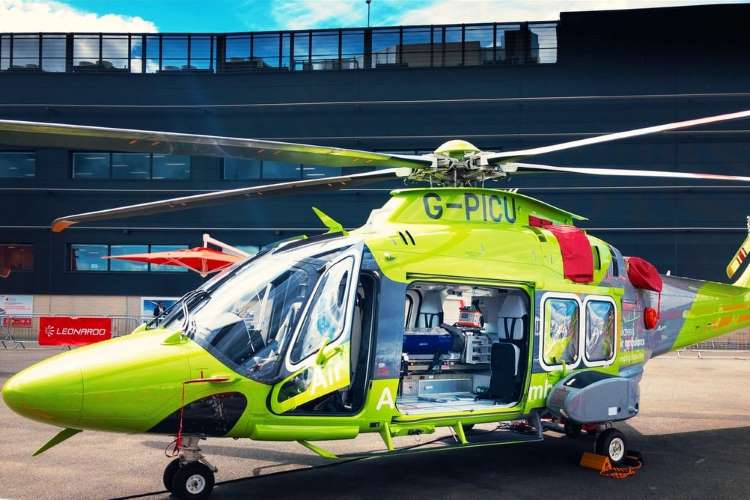
By Dhananjay Suri
World nations investing in HEMS network: The Covid-19 pandemic helped separate grains from chaff when it comes to governance standards. Even the minutest of lapses affected many lives. Undoubtedly the woeful state of affairs of healthcare services all around the world stood out. Though this was no big reveal, universal access to healthcare has often been overlooked by governments globally. Even among the rich nations, healthcare has often been ignored at the cost of prioritising numerous other areas. However, this trend is set to change.
Increasingly a large number of nations are moving towards universalisation of healthcare which once used to be the calling card of the welfare states in Scandinavia. While India is far from providing quality healthcare for its citizens, the introduction of health insurance under Ayushman Bharat and the recent 137% increase in the healthcare budget for FY22 are steps in the right direction.
Though an increase in the health budget was much needed even before the pandemic, it is nevertheless a great initiative by the Union government to focus on improving access to healthcare. This course of action by the government becomes all the more crucial in the backdrop of the rising aspirations of the people and the emergence of new technologies to solve their problems.
READ I Global factors driving inflation, fuel tax cut seems the only option
World nations investing in HEMS
These changing trends were amplified during the second wave of Covid-19 wherein people found it difficult to access healthcare services in time, thus making it imperative for the creation of a robust Helicopter Emergency Medical Service (HEMS). A strong HEMS network will not only further the objective of the government in aspiring to achieve universalisation of healthcare, but will also be beneficial in preparing India against future national emergencies including the possibility of a third wave of Covid-19.
HEMS is the use of helicopters to provide medical services to the civilian population. Traditionally, air medical evacuation was provided by aircrafts for military purposes. It was only during the Korean and Vietnam wars that helicopters were deployed for medical purposes, leading to them eventually becoming more frequently used than aircrafts.
Presently, HEMS is being adopted by increasing number of countries worldwide because of its vast benefits. As compared to a road ambulance, a helicopter ambulance is much faster, saves time and can reach areas that are not well connected. Thus, HEMS reduces the many fatalities caused due to the lack of timely intervention of medical services — which happens to be one of the main causes for growing fatalities worldwide.
READ I Widows in India: Invisible women facing invisible problems
Hems can raise healthcare coverage
Today, when 30% of the helicopters abroad are estimated to be equipped for medical and allied services, the HEMS industry in India is virtually nonexistent with only a few helicopters being used. With a large population and unevenly available medical infrastructure in the country, suitable demand can be created for an indispensable and necessary HEMS industry with appropriate support from the regulators.
According to WHO, the ideal allopathic doctor to patient ratio is 1:1000. For India as a whole, the ratio is 1:1511 (15th Finance Commission) but this hides the inconsistent spread across states. While Andhra Pradesh has 1 doctor for every 491 citizens in neighbouring Telangana this ratio is 1: 7121 people.
Much of the obstacles that prevent the HEMS industry from taking-off and creating a real change within the country can be attributed to policy and infrastructural issues. India continues to have a restricted airspace policy that does not allow helicopters to fly freely in a non-controlled airspace and below 5000 feet during emergency situations without obtaining prior approvals from the ATCs.
READ I A crisis communication playbook as Bay of Bengal turns into the womb of cyclones
The National Civil Aviation Policy, 2016 had mooted the idea of creating exclusive guidelines for HEMS. The policy recognised the need for enabling air ambulances to operate without operational clearances and the ability of air ambulances to land at any accident or emergency site without any clearances except that of Air Defense Clearances.
Such measures have still not been implemented. In terms of infrastructure, the creation of helipads for successful HEMS operations is still lacking. At a time when the Union and various state governments are increasing their investments in opening state-of-the-art hospitals, the existing hospitals do not have a provision for a helipad. The older hospitals can be fitted with helipads on rooftops or within the hospital premises as per availability with not much investment. This can aid in significantly improving the connectivity of such hospitals via helicopters which remains absent.
In contrast, India’s northern neighbor China has already set the ball rolling for creating a well-planned HEMS infrastructure. For instance, the Chinese regulators have relaxed the restrictions on the usage of low-altitude airspace which will provide the much-needed support for the growth of the HEMS industry in that country.
The ongoing pandemic has taught us in no uncertain terms that health is the real wealth. India’s drive to revive the economy should pivot itself around the development of healthcare infrastructure and HEMS can be an important element of this effort. This move will not only catalyse the advancement of the long-stunted civil helicopter industry, but it will also align with the government’s vision to create a regional air ambulance agreement for South Asia and Indian Ocean nations, thus furthering India’s sphere of goodwill.
(Dhanajay Suri is a lawyer and a public policy consultant at Chase India.)
